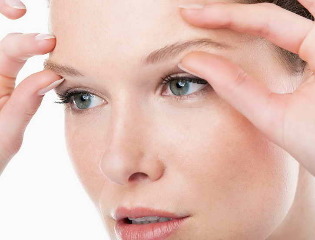
Eyelid enhancement is a complex of hardware, injection and manual manipulation aimed at rejuvenating and modeling the periorbital area (the area around the eye). This part of the face is considered a zone of increased sensitivity, therefore the correction of non-surgical aesthetic eyelids is a difficult task even for highly qualified and widely experienced specialists. Micro cosmetology and aesthetic medicine today offer several effective methods for lifting the eyelids: lifting radio waves, bio-reinforcement with threads, contour plastics, photo rejuvenation, micro therapy. You can choose the most appropriate technique only after a visual examination of the problem area, review the patient's medical history, purpose and ideas on the final results.
Privileges of lifting periorbital
The eyelid area, also called the periorbital zone (which is not entirely true, because the lacrimal apparatus, palpebral fissure and conjunctival sac are also included in the periorbital space, in addition to the eyelids), is one of the most sensitive areas of the human body with layersthin dermis and minimum subcutaneous fat. The eyelids are musculoskeletal folds, bound by conjunctival tissue and cartilage. They are located around the eyes and perform several functions at once: protect the cornea and retina from the negative effects of environmental factors (ultraviolet radiation, dust, etc. ), clean the connective tissue membranes due to constant wetting with tear fluid, 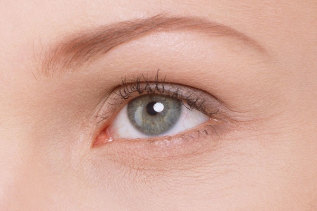 prevents drying of the sclera and the cornea.
prevents drying of the sclera and the cornea.
The skin in the eyelid area is several times thinner than other parts of the face, so it is more prone to age and stress-related changes, which in most people become noticeable after 30 years. At this age, the body's natural dehydration process begins, as a result of which the epidermal cells lose moisture, and the skin loses its elasticity, becoming loose and sagging. In the periorbital zone in men and women over 30 years the first signs of aging are formed: hypodynamic folds, imitation of wrinkles, folds in the outer corners of the eyes ("crow's feet").
Eyelid removal is a complicated task that should only be performed by a highly qualified and highly knowledgeable doctor on the topography of the eye topography, as improper action can not only cause new defects, but also seriously impair the function of the organs of vision. The fact is that the eyelids are involved in the formation of the focus of the eye and the optical geometry of the cornea, as well as in the arrangement of intraocular pressure, therefore, improper plastic operation and lifting can provoke impaired visual function (in some cases, irreversible).
Who needs eyelid lift
The removal of the periorbital zone does not have strict medical indications (except for surgical corrections, which are often used to treat pathologies that interfere with the normal functioning of the organs of vision) and are usually performed at the patient's request to remove visible aesthetic defects. Cosmetics and plastic surgeons cover the following defects for such defects:
- strong supraorbital fold overhang;
- excess skin in infraorbital musculoskeletal folds;
- drooping corners outside the eyes;
- protruding periorbital (fatty hernia);
- periorbital edema (sac);
- vascular pathology leading to the appearance of scars of rosacea and dark circles under the eyes;
- hypodynamic wrinkles;
- "crow's feet" (folds at the corners of the eyes);
- very noticeable infraorbital grooves;
- "eyelid aging" (withering and softening of the eyelid skin).
Increased eyelids also help create a fresher and more open appearance by correcting hanging skin and periorbital fat bags and improving the overall tone of the area.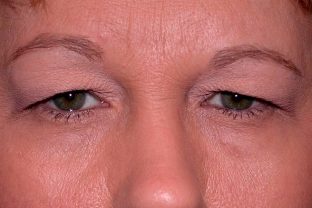 The timely use of various methods to rejuvenate the area around the eyes helps to complete one of the main tasks of lifting periorbital - to hide age-related skin changes and to remove the visual defects of dermis biological aging features against the background of potential decline in epidermal cell function.
The timely use of various methods to rejuvenate the area around the eyes helps to complete one of the main tasks of lifting periorbital - to hide age-related skin changes and to remove the visual defects of dermis biological aging features against the background of potential decline in epidermal cell function.
Important! Aging and heavy eyelids are relatively serious aesthetic defects that can ruin a young and attractive face. For some people, signs of skin aging in this area may appear before the age of thirty (for example, in patients with low weight or in people with endocrine system pathology). As a rule, cosmetics are ineffective in repairing existing problems and are only suitable for preventing premature aging, so the only effective method to overcome this defect is to lift the periorbital.
Eyelid Removal Surgery
The operation to lift the skin on the upper and lower eyelids is called blepharoplasty. This is a type of radical removal of the periorbital zone, where the effect of tightening and rejuvenation is achieved by removing excess skin and fat hernias in the eyelid area.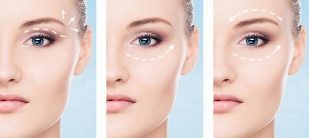 Unlike non-surgical eyelid lifting methods, blepharoplasty not only makes it possible to improve skin aging defects and improve the appearance of these areas, but also to improve the shape and shape of the eyes, as well as get rid of various pathologies.
Unlike non-surgical eyelid lifting methods, blepharoplasty not only makes it possible to improve skin aging defects and improve the appearance of these areas, but also to improve the shape and shape of the eyes, as well as get rid of various pathologies.
Blepharoplasty is effective for serious eye diseases such as entropion (swelling of the eyelashes and the edges of the eyelids toward the eyeballs) or exophthalmos (displacement of the eyeballs outside the orbit). In total, there are three types of blepharoplasty: upper, lower and round.
Table. Types of radical periorbital adoption
| Type of operation | Section area | What pathology can be improved |
|---|---|---|
| Blepharoplasty supraorbital | Skin incisions made along orbit or tarsal folds on upper eyelids. | Removal of excess skin, subcutaneous fat and muscle plastic. |
| Blepharoplasty suborbital | Transcendent or subcliliary incisions are performed. | Removal of periorbital edema, bags under the eyes, fatty hernias. |
| Round Blepharoplasty | Simultaneous eyelid surgery on both sides. | Solve common problems in all types of blepharoplasty. |
Periorbital zone tightening surgery is performed strictly in a hospital setting, excluding the possibility of outpatient procedures. Patients were given general anesthesia, and the duration of the intervention, on average, was about 3 hours. Significant disadvantages of this method of lifting the eyelids are the postoperative period, which, although it has a short duration (about two weeks), is characterized by pain, the need for periodic bandages and antiseptic treatment, and significant restrictions on the regime andprofessional activities.
Important! The advantage of surgical blepharoplasty is the ability not only to tighten the skin of the eyelids, but also to perform plastic surgery on muscle tissue, which can not be achieved using hardware and other minimally invasive methods.
Tightening of the periorbital zone without surgery
Surgical eyelid surgery is a very effective method of radical rejuvenation in the area around the eyes, but experts advise using it only to patients from the older age group (after 40 years) with obvious signs of aging and associated skin changeswith old age. Before reaching this age, while tissue hydrodynamics are in the normal range, there are many less traumatic ways to correct existing problems, and the effectiveness of a large number of these techniques in some cases can be compared with surgical plastic results.
Plastic injection (contour)
Plastic contours may be the safest method to tighten eyelid skin without surgery, which is associated with mesotherapy procedures according to its technique. Contour is a typical implant subdermal injection called a filler.
This is a preparation in the form of a homogeneous and viscous suspension or gel based on components that have a high affinity for the body tissue itself. This can be:
- hyaluronic acid;
- calcium hydroxyapatite;
- collagen (a peptide synthesized by fibroblasts and one of the key elements of the dermis extracellular substance, which ensures its elasticity and ability to stretch);
- polymers based on acrylic and metacrylic acids;
- high oxygen molecular weight silicon;
- polylactic acid;
- tripolifosphoric acid salts, etc.
The most popular and requested filler for periorbital lift is a preparation based on hyaluronic acid. These are biodegradable (non-absorbent) decomposable skin implants, which not only overcome the lack of tissue in this area, but also help eliminate wrinkles - one of the main visual signs of facial aging. The advantages of hyaluronic fillers include high hypoallergenicity and excellent results, which can be appreciated immediately after implantation. Bioresorpsi hyaluronate occurs within a few weeks, after which the injection must be repeated.
Biosynthetic implants based on polylactic acid and calcium hydroxyapatite maintain their properties for 1-2 years.
RF adoption
Lifting of radio waves or radio frequencies is the lifting of non-surgical areas around the eyes with a high degree of effectiveness.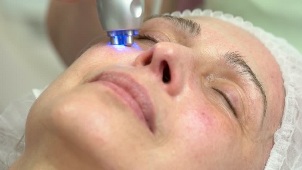 Among the hardware techniques for minimally invasively lifting the upper and lower eyelid skin, RF removal occupies a leading position, as it makes it possible not only to achieve immediate tightening effect, but also to significantly improve skin condition in the periorbital zone.
Among the hardware techniques for minimally invasively lifting the upper and lower eyelid skin, RF removal occupies a leading position, as it makes it possible not only to achieve immediate tightening effect, but also to significantly improve skin condition in the periorbital zone.
Radio waves, permeate into the dermis to the required depth, heat the epidermal cells to the temperature of collagen compaction, which is around 60 ° C. compressed again and take the shape of their characteristic spiral, which is a lifting effect.
RF adoption is suitable for improving all age-related problems in the area around the eyes (crow's feet, hypodynamic wrinkles, eyelid ptosis, etc. ), and the results achieved last up to 1-2 years. To achieve a stable rejuvenating effect, you need to perform about 6-10 procedures with an interval of at least 7-10 days.
Bio reinforcement with thread (lifting thread)
Thread removal is a procedure for rejuvenating the area around the eyes, which is based on the cultivation of special cosmetic yarns made of various metals and synthetic materials under the skin, resulting in a new collagen framework formed in the subdermal layer. This procedure is quite effective and allows you to overcome the problem of "aging of the eyelids", fatty periorbital hernias, the phenomenon of gravity ptosis and other phenomena that are characteristic of skin aging.
There are several types of threads for lifting threads. Yarns made of precious metals are very popular in the field of cosmetology. This thread is made of platinum or gold and is designed to strengthen the top layer of the dermis. Gold yarn not only provides a visible lifting effect, but also stimulates cell metabolism, increasing the supply of nutrients, oxygen and vitamins to dermal cells. A serious disadvantage of threads made of precious metals is the high risk of detachment and the impossibility of using many cosmetic procedures, for example, phototrolysis after reinforcement.
Liquid mesothread is mainly used to overcome small hypodynamic folds, correct "eyelid aging" and smooth the skin in the periorbital zone. The duration of such a procedure does not exceed 20-30 minutes, but reinforcement with liquid thread has many contraindications and is often accompanied by various side effects (swelling, bruising, redness). Experts believe that the most effective types of eyelash lifting are Swiss, polylactic and Korean threads. The result after the reinforcement lasted for about 2-3 years.
Fractional photothermolysis
Fractional photothermolysis is another effective method for tightening skin without surgery on the upper and lower eyelids. This is a type of laser rejuvenation in which fractional laser generators (e. g. , erbium lasers) are used to affect problem areas. The beams produced by this device are spread over many streams and, upon touching the skin, form a large number of microtermal healing zones, where the main effect occurs, so that the surrounding tissue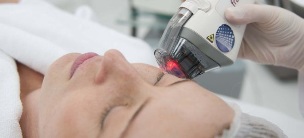 is not hot and does not injure.
is not hot and does not injure.
The special feature and at the same time the main principle of fractional phototrolysis action is to warm the skin at a temperature of 250-300 ° C, which experts call evaporation procedures. Old cells, altered and pathologically destroyed under the influence of such temperatures are destroyed and evaporated, while natural neocolollagenesis is activated and fibroblass activity increases, which synthesizes the main components of the extracellular matrix - peptides (collagen and elastin).
The result of fractional laser mounting is significant skin tightening of the eyelids, smoothing wrinkles and folds, restoring the hydrodynamics of periorbital tissue and improving the general condition of the skin in this area.
Pulse current (micro cryptocurrency)
Micro therapy refers to the method of lifting low trauma eyelids, but a significant disadvantage of this method is the short yield period (not more than 4 months). The clinical results of the use of micro therapy to lift the periorbital zone are due to the nature of the following impulse currents:
- normalizes lymph flow.The effect of lymphatic drainage, which has an impulse current on the skin, increases lymph movement, prevents its stagnation and helps to lighten dark circles under the eyes;
- stimulation of metabolic processes.Activation of cell metabolism has a positive effect on oxygen and nutrient transport and skin appearance (skin becomes smooth, acquires a healthy appearance);
- muscle tone recovery.The eyelid muscles are relatively weak, and additional stimulation allows you to achieve a tightening effect.
The duration of the standard course is from 10 to 20 procedures, while in most cases it is necessary to repeat the procedure after a few months.

Before and after photos
Conclusion
Lifting the eyelids is difficult, but at the same time doable, for solutions in which modern aesthetic medicine offers a large number of effective methods, including low trauma manipulation with low probability of complications. Which method of lifting the periorbital is most effective and safe is decided individually after discussing with the patient, diagnosing problem areas and reviewing medical history data.
The use of surgical techniques is indicated especially for patients with obvious signs of aging in the area around the eyes, where the use of gentle techniques is ineffective and may not provide stable positive results. People with early manifestations of the "aging age" are better off choosing minimally invasive methods with low levels of tissue trauma and short recovery periods.
























































